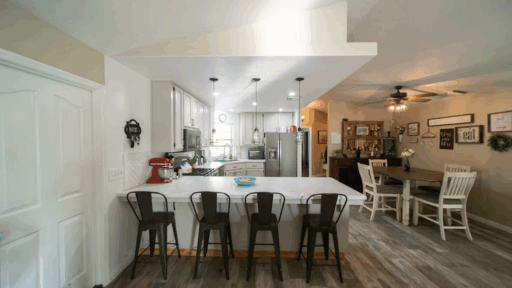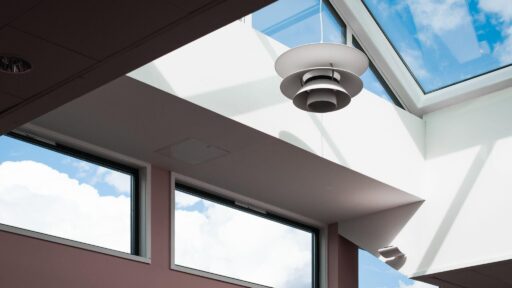When I first began searching for the perfect countertop, I thought it would be straightforward. But then I fell into the world of Quartz, Granite, and Marble and suddenly, I had decisions to make.
All three are gorgeous and durable in their own way, and are used in homes around the world.
But they each perform differently under pressure (literally). I looked into everything, durability, cost, appearance, and daily maintenance and tried to picture how each one would hold up in my kitchen.
In this blog, I’ll walk you through what I learned, what impressed me, and what I’d actually pick for my space.
If you’re torn between these three, this breakdown should help you decide with confidence.
What Is Granite?

Granite is a 100% natural igneous rock that forms deep within the Earth as magma cools slowly over time.
This slow cooling process creates a dense, durable stone filled with quartz, feldspar, and mica, which give it its distinctive speckled appearance.
Each slab of granite is unique, featuring natural variations in color and pattern that make it a popular choice for homeowners seeking a one-of-a-kind surface.
Known for its heat resistance and strength, granite is a top choice for kitchen countertops, especially in busy households.
While it does require periodic sealing to protect against stains and bacteria, its overall toughness and natural beauty make it a long-lasting and practical investment for both indoor and outdoor use.
What Is Marble?
Marble is a metamorphic rock formed when limestone is subjected to intense heat and pressure deep beneath the Earth’s surface.
This natural transformation creates a dense, crystalline structure with flowing veins and elegant color variations.
Made mostly of calcite, marble is softer and more porous than granite or quartz, which means it can etch or stain more easily if not properly sealed and maintained.
Despite its delicate nature, marble remains a favorite for bathrooms, vanities, and decorative surfaces because of its luxurious look and timeless appeal.
Its cool surface also makes it popular with bakers and chefs. If you love classic design and don’t mind a little extra maintenance, marble is a stunning choice.
What Is Quartz?
Quartz countertops are engineered surfaces composed of natural quartz crystals combined with resins and pigments.
This mix is compressed and cured to form a hard, non-porous slab that mimics the look of stone but offers more consistency in color and pattern.
Unlike granite and marble, quartz is man-made, which means it’s available in a wide range of colors and styles, from solid tones to realistic marble-look veining.
It’s highly durable, stain-resistant, and doesn’t require sealing, making it ideal for kitchens, bathrooms, and high-traffic areas.
Quartz is ideal for homeowners seeking a low-maintenance surface that combines both function and aesthetics.
Quartz vs Granite vs Marble: Key Comparison
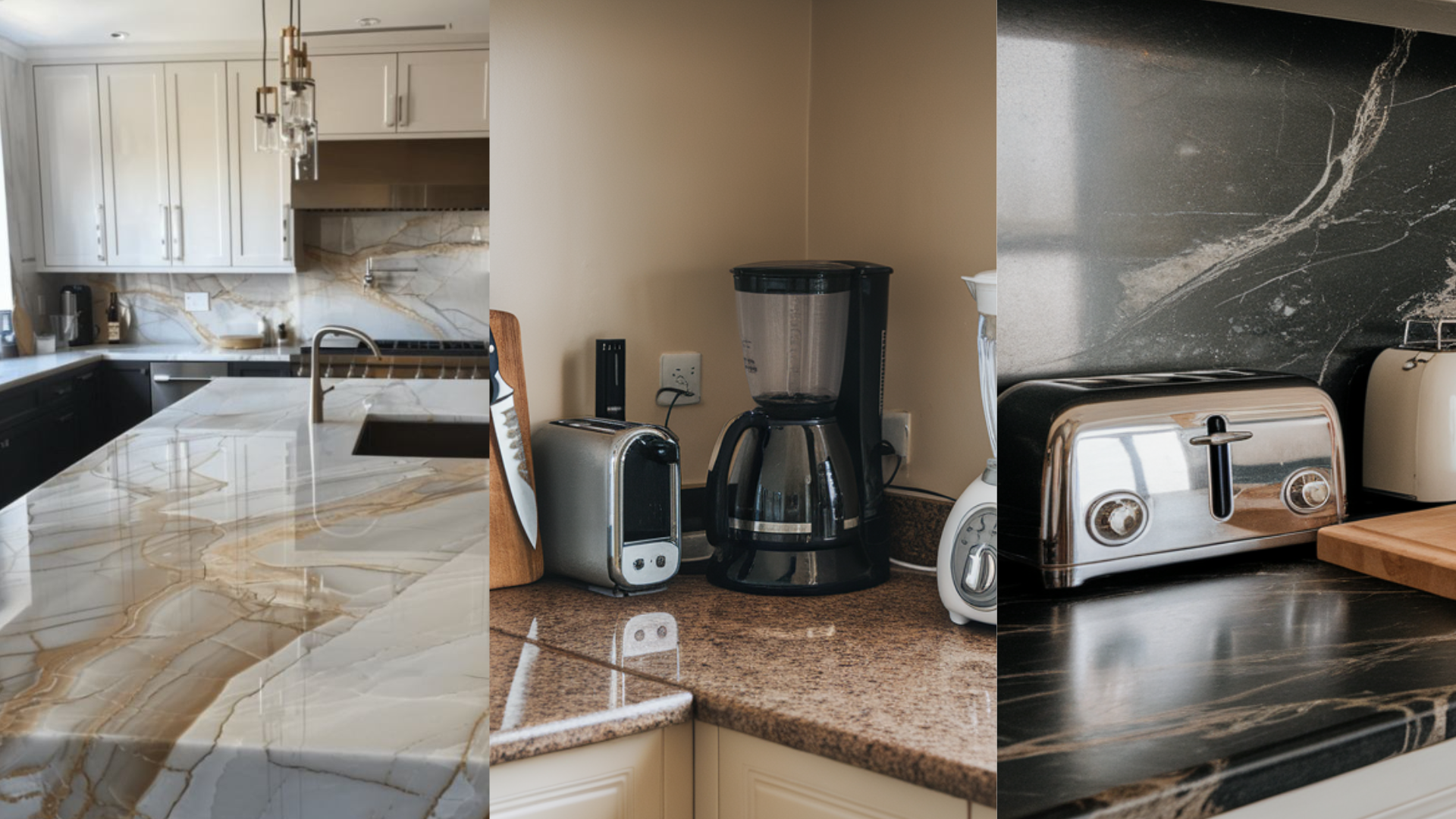
This table offers a detailed side-by-side comparison of quartz, granite, and marble, covering durability, maintenance, appearance, and cost. It’s a helpful guide for selecting the right material based on your space, style, and budget.
| Feature | Quartz | Granite | Marble |
|---|---|---|---|
| Material Type | Engineered stone (quartz + resin) | Natural igneous rock | Natural metamorphic rock |
| Appearance | Uniform patterns, wide color range | Natural variation with specks and grains | Elegant veining, soft and classic look |
| Heat Resistance | Moderate, use trivets | Excellent, handles hot pans directly | Low ,sensitive to heat and may scorch |
| Scratch Resistance | High, resists most scratches | High, durable under heavy use | Low, prone to scratches and etching |
| Stain Resistance | Excellent, non-porous and sealed | Moderate, needs sealing to resist stains | Low, easily stained without regular sealing |
| Porosity | Non-porous, no sealing required | Porous, requires sealing annually | Highly porous, frequent sealing recommended |
| Maintenance | Very low, simple cleaning with soap and water | Moderate, needs sealing and care with acids | High, avoid acids, frequent sealing required |
| Durability | Very durable, resistant to impact and wear | Extremely durable, ideal for high-traffic areas | Less durable, suitable for low-use areas |
| Best For | Indoor kitchens, baths, backsplashes | Kitchens, outdoor spaces, bar tops | Bathrooms, vanities, decorative surfaces |
| Sunlight/UV Stability | Not UV-stable can fade in direct sun | UV-stable, suitable for sunny or outdoor spaces | UV-sensitive, may discolor over time |
| Cost (Installed) | $50–$100 per sq. ft. | $40–$85 per sq. ft. | $50–$120 per sq. ft. |
| Design Flexibility | High, wide range of colors and styles | Moderate depends on available slabs | Limited and fewer color options, but highly elegant |
1. Durability and Strength
Each material brings its own level of toughness. Knowing how quartz, granite, and marble handle wear helps you plan smarter.
- Granite is one of the toughest natural materials used in homes. It resists chips, scratches, and heat exceptionally well, making it ideal for kitchens and other high-use areas. It holds up to everyday wear without losing integrity.
- Quartz, being engineered, is also very durable. It’s less likely to crack or chip under pressure and doesn’t require sealing. However, it’s more prone to heat damage than granite and can discolor or warp under high temperatures.
- Marble is the softest of the three. It’s more porous and prone to scratching, chipping, and etching, especially when exposed to acids like vinegar or lemon juice. It’s best suited for low-traffic or decorative areas.
If durability is your top priority, granite is the strongest overall, with quartz close behind. Marble brings elegance, but requires gentle use and regular maintenance to prevent damage.
2. Appearance and Color Options
Visual appeal varies greatly by surface. The color range and patterns available in each type can shift your design direction.
- Quartz offers uniformity and variety. Since it’s man-made, you can find it in nearly any color or pattern—solid, speckled, or veined. It can even mimic marble or granite, making it great for modern, coordinated spaces.
- Granite is completely natural, so every slab is unique. It features bold veining, mineral speckles, and natural movement, ranging from neutral to vibrant hues. If you want character and natural variation, granite delivers.
- Marble is prized for its soft, elegant veining and creamy hues. White marble with gray veining is a timeless look, often seen in luxury bathrooms and classic kitchens. It has a distinct, upscale aesthetic.
Quartz is perfect for uniform designs. Granite is ideal for nature-inspired, bold looks. Marble stands out with timeless beauty. Your choice will depend on the style you’re aiming for, whether it’s sleek and modern, rustic, or refined.
3. Cost Breakdown
Budget plays a big role. Comparing typical installed prices helps set expectations and guide which material is realistic for your space.
- Quartz typically costs between $70 and $120 per square foot installed. Prices vary based on color, brand, and finish. It’s more expensive than some granite options but requires less maintenance over time.
- Granite generally ranges from $50 to $100 per square foot installed. Prices depend on rarity and source. Some exotic stones can be pricier than quartz, but more common options are affordable and durable.
- Marble tends to cost $60 to $150 per square foot installed. White marble varieties like Carrara are more affordable, while Calacatta or imported slabs cost more due to rarity and sourcing.
Choose based on your budget and how much long-term care you’re willing to do.
4. Heat and Scratch Resistance
Kitchens get messy and hot how your surface reacts to pans, knives, and daily impact matters more than you might think.
- Granite is heat- and scratch-resistant. Hot pans won’t damage it, and it’s tough against daily use. However, repeated exposure to extreme heat can eventually cause cracks or discoloration.
- Quartz handles scratches well but isn’t heat-proof. The resin in quartz can melt or warp under direct contact with hot pots. Always use trivets to avoid heat damage, even in casual use.
- Marble scratches and chips easily. It can also scorch or discolor if exposed to heat. Using cutting boards and avoiding hot pans is crucial to protect the surface.
For kitchens with heavy cooking and constant use, granite performs best. Quartz holds up well but needs heat protection. Marble is the most sensitive, better suited for places without intense use or heat exposure.
5. Maintenance and Cleaning Needs
No one wants a high-maintenance countertop. Understanding each surface’s upkeep makes long-term care easier and more predictable
- Quartz is non-porous and doesn’t require sealing. It’s easy to clean with mild soap and water. It resists stains, bacteria, and moisture perfect for busy homes needing a low-maintenance solution.
- Granite is porous and should be sealed annually to prevent staining. With sealing and simple cleaners, it remains easy to maintain and is resistant to bacteria and spills.
- Marble is the most high-maintenance. It’s porous and reacts to acids, so it stains and etches easily. It needs sealing and gentle, pH-neutral cleaners to stay beautiful.
If you want a countertop you don’t have to worry about, quartz wins on ease. Granite needs minor upkeep but stays strong. Marble requires the most care and regular sealing to preserve its elegance.
6. Resale Value and Buyer Preferences
What looks great to you might matter differently to future buyers. These surfaces affect how homes are viewed on the market.
- Quartz is considered a modern, high-end material that appeals to buyers looking for low-maintenance, stylish finishes. It often helps homes appear newer and well-maintained on the market.
- Granite remains a popular choice among buyers who appreciate natural materials. Its reputation for strength and unique beauty adds to a home’s perceived value, especially in traditional or transitional kitchens.
- Marble has a timeless appeal and is seen as luxurious. While its upkeep may be a drawback for some, buyers seeking elegance and high-end finishes often see marble as a major bonus.
All three materials can add resale value. Quartz is best for practical buyers, granite appeals to a wide range of tastes, and marble attracts those with a love for timeless, classic design.
7. Environmental Impact and Sustainability
Choosing a surface isn’t just about looks; it’s also about how it’s made and what that means for the planet.
- Granite is a natural material, but its environmental impact comes from quarrying and long-distance transport. Once installed, its long lifespan offsets some of the extraction concerns.
- Quartz is man-made using natural quartz and synthetic resins. Some brands use recycled materials and energy-efficient methods, making it more sustainable than it used to be. Its durability also reduces waste over time.
- Marble is natural like granite, but the quarrying process impacts the environment. Since it can wear down faster and may need replacing sooner, it might not be the greenest option in the long run.
If eco-conscious design is important, look for quartz made with recycled content or locally sourced granite. Marble’s sustainability depends on how it’s sourced and maintained over its lifespan.
Pros and Cons: Quartz vs Granite vs Marble
A quick rundown of the strengths and trade-offs of quartz, granite, and marble to help you compare them side by side before making your final decision.
| Material | Pros | Cons |
|---|---|---|
| Quartz | Low maintenance, uniform look, stain-resistant | Not heat-proof, limited to indoor use |
| Granite | Natural patterns, heat-resistant, durable | Requires sealing, can be pricey |
| Marble | Elegant appearance, timeless design appeal | Scratches, stains, and etches easily |
Conclusion
Each surface has its own charm, but if I had to choose?
I’d go with Quartz for my daily kitchen. It’s easy to clean, low-fuss, and still looks sleek.
Granite is my pick for a bold, natural look with tough performance great for heavy use or even an outdoor setup.
Marble is stunning, no doubt, but I’d save it for a quiet bathroom or decorative spot, not my main workspace.
In the end, it’s not about the “best” countertop it’s about what works for you. Think about your habits, your space, and how much maintenance you’re okay with.
Still torn? Head to a showroom, grab a few samples, and test them in your own lighting.
Trust me, seeing them at home makes the decision much easier

